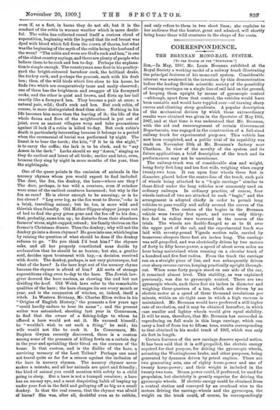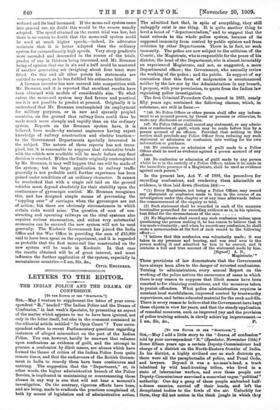CORRESPONDENCE.
THE BRENNAN MONO-RAIL SYSTEM.
[To THE EDITOR 07 THE "SPECTATOR") SIE,—In May, 1907, Mr. Louis Brennan exhibited at the Royal Society a working model of a railway truck illustrating the principal features of his mono-rail system. Considerable interest was awakened in the invention by this demonstration before the leading British scientific society of the possibility of running carriages on a single line of rail laid on the ground, of keeping them upright by means of gyroscopic control —although, apart from that control, the vehicles would have been unstable and would have toppled over—of turning sharp curves and climbing steep gradients. A popular description of the mechanical devices by which these extraordinary. results were obtained was given in the Spectator of May 18th, 1907, and at that time it was understood that Mr. Brennan, with the aid and encouragement of certain Government Departments, was engaged in the construction of a, full-sized railway truck for experimental purpases. This vehicle has now been completed, and a public trial of its capability was made on November 10th at Mr. Brennan's factory near Chatham. In view of the novelty of the system and its future applications, a brief description of the truck and its performances may not be unwelcome.
The railway-truck was of considerable size and weight, being forty feet long and ten feet wide, weighing when empty twenty-two tons. It ran upon four wheels three feet in diameter, placed below the centre-line of the truck, each pair of wheels being attached to a " bogie carriage" similar to those fitted under the long vehicles now commonly used on ordinary railways. In ordinary practice, of course, four wheels instead of two are attached to each "bogie," and the arrangement is adopted chiefly in order to permit long vehicles to pass readily and safely around the curves of the railway-line. The centres of the bogies in the Brennan vehicle were twenty feet apart, and curves only thirty- five feet in radius were traversed in the course of the trials. The wheels are double-flanged so as to fit over the upper part of the rail, and the experimental track was laid with seventy-pound Vignole section rails, carried by transverse sleepers three feet six inches long. The carriage was self-propelled, and was electrically driven by two motors of forty to fifty horse-power, a speed of about seven miles an hour being maintained when running on a circular track of a hundred and five feet radius. From the track the carriage ran on a straight piece of line, and was subsequently driven over sharp reverse curves, keeping practically upright through- out. When some forty people stood on one side of the car, it remained almost level. This stability, as was explained previously, was due to gyroscopic control. There are two gyroscopic wheels, each three feet six inches in diameter and weighing three-quarters of a ton, which are driven by an electric motor at a speed of three thousand revolutions per minute, within an air-tight case in which a high vacuum is maintained. Mr. Brennan would have preferred a still higher rate of revolution, and it may be obtained hereafter, in which case smaller and lighter wheels would give equal stability. It will be seen, therefore, that Mr. Brennan has succeeded in reproducing on full scale in this large carriage, which can carry a load of from ten to fifteen tons, results corresponding to that obtained in his model truck of 1907, which was only six feet in length.
Certain features of the new carriage deserve special notice. It has been said that it is self-propelled, the electric energy required for that purpose, for driving the gyroscopic wheels, actuating the Westinghouse brake, and other purposes, being generated by dynamos driven by petrol engines. There are
two generating sets, one of eighty horse-power and one of twenty horse-power; and their weight is included in the twenty-two tons. Steam power could, if preferred, be used for propulsion, but electricity is greatly superior for driving the gyroscopic wheels. If electric energy could be obtained from a central station and conveyed by an overhead wire to the motors driving the carriage-wheels and the gyroscopes, the weight on the truck could, of course, be correspondingly
reduced and its load increased. If the mono-rail system came into general use, no doubt this would be the course usually adopted. The speed attained on the recent trial was low, but there is no reason to doubt that the mono-rail system could be used at much higher speeds,—indeed, its advocates maintain that it is better adapted than the ordinary system for extraordinarily high speeds. Very steep gradients were ascended and descended in the course of the trials, grades of one in thirteen being traversed, and Mr. Brennan being of opinion that one in six and a half could be mastered if another generating set (weighing about four tons) were fitted. On this and all other points his statements are entitled to respect, as he has fulfilled his estimates hitherto.
A German inventor has now entered into competition with Mr. Brennan, and it is reported that excellent results have been obtained with models of considerable size. To what extent the mono-rail system may find favour and practical use it is not possible to predict at present. Originally it is understood that Mr. Brennan contemplated its employment for military purposes, or in new and sparsely peopled countries, on the ground that railway-lines could thus be made much more cheaply and rapidly than on the ordinary system. Reports on the Brennan system have, it is believed, been made—by eminent engineers having expert knowledge of railway construction and electric traction— to the Government Departments specially interested in the subject. The nature of these reports has not trans- pired, but it is reasonable to suppose that exhaustive trials with the vehicle now available will be made before any final decision is reached. Within the limits originally contemplated by Mr. Brennan, it may well happen that use will be made of the system; but its large application to railway traffic generally is not probable until further experience has been gained under conditions of an ordinary character. It cannot be overlooked that with a single rail laid on the ground vehicles mast depend absolutely for their stability upon the continuance of gyroscopic controL Mr. Brennan recognises this, and has designed simple means of preventing the "toppling over" of carriages when the gyroscopes are out of action ; but there are obviously circumstances in which certain risks would arise. The question of cost of con- structing and operating railways on the rival systems also requires serious examination, and unless very substantial economies can be ensured the new system will not be used generally. The Kashmir Government has joined the India Office and the War Office in providing the sum of 215,000 said to have been spent on the experiment, and it is regarded as probable that the first mono-rail line constructed on the new system will be made in Kashmir. In that case the results obtained will be of great interest, and must influence the further application of the system, especially in mountainous countries.—I am, Sir, &C., CIVIL ENGINEER.

























































 Previous page
Previous page